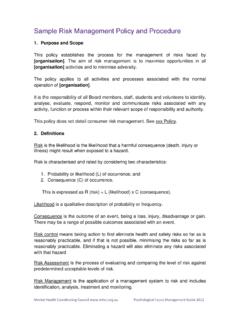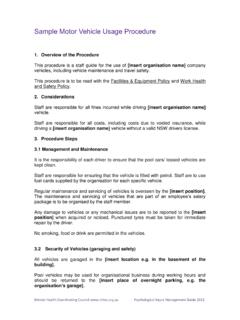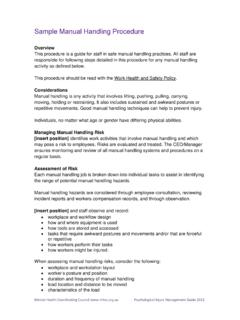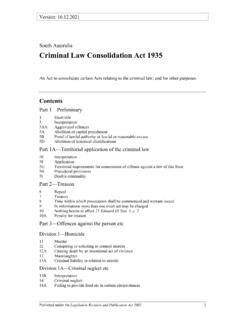Transcription of Sample Emergency and Critical Incident Policy and Procedure
1 Mental Health Coordinating Council Psychological Injury management Guide 2012 Sample Emergency and Critical Incident Policy and Procedure 1. Purpose and Scope Emergencies and Critical incidents in the workplace can affect people physically and psychologically, and affect program continuity of [insert organisation name]. The purpose of this Policy is to ensure [insert organisation name] prepares for and effectively responds to Emergency situations and Critical incidents through the appropriate use of resources. The prevention and effective management of Emergency situations and Critical incidents can assist to minimise the negative impact of an unexpected event. This Policy applies to all staff, consumers, volunteers, Board members and students. 2. Definitions An Emergency is an unplanned or imminent event that affects or threatens the health, safety or welfare of people, property and infrastructure, and which requires a significant and coordinated response.
2 The defining characteristic of an Emergency event or situation is that usual resources are overwhelmed or have the potential to be overwhelmed. Emergencies may be a specific event with a clear beginning, end and recovery process, or a situation that develops over time and where the implications are gradual rather than immediate. Emergency management is the coordination of an Emergency response and management of recovery. The aim of Emergency management is to minimise physical and psychological impacts on all parties and to minimise damage to assets, operations, reputation and staff productivity. A Critical Incident is an unexpected traumatic event, involving personal or professional threat, which evokes extreme stress, fear or injury.
3 Providing appropriate supports following a Critical Incident is part of Emergency management . A traumatic event is one in which a person experiences, witnesses or is confronted by experiences that involve actual, threatened or perceived death or serious injury and/ or threat to own or others physical and emotional integrity. The person s response may then include intense fear, feelings of helplessness and horror, which impact on their sense of self . Complex trauma refers to a condition resulting from multiple exposures to one or more traumas. When repeatedly exposed to traumatic stress, disruptions can occur in brain structure and function, central and autonomic nervous system arousal, endocrinological and immunological function. These biological disruptions interact with psychological, emotional, cognitive and spiritual processes Mental Health Coordinating Council Psychological Injury management Guide 2012 Critical Incident Debriefing (CID) is a preventative health measure to minimise the impact of traumatic events and the development of major psychological health problems such as Post Traumatic Stress (PTS) Disorder.
4 3. Principles Emergency management planning is being prepared for events or incidents that stretch our ability to cope beyond normal day-to-day capacity. The organisation is committed to the protection of consumers, staff, volunteers, Board members, students and visitors during emergencies. [insert organisation name] swiftly and effectively responds to Emergency situations, with the foremost goals of preserving life, protecting the organisation s property, and restoring operations as quickly as possible. Critical incidents can be a threatening experience and appropriate supports are required to minimise long term effects arising from exposure to the trauma. 4. Outcomes Emergency situations are prevented as far as practical. The negative impacts of Emergency situations and Critical incidents are minimised through effective management .
5 5. Functions and Delegations Position Delegation/Task Board of Directors Develop and Review Emergency and Critical Incident Policy . Compliance with Emergency and Critical Incident Policy . management Compliance with Emergency and Critical Incident Policy . CEO/Manager Ensures development and implementation of Emergency and Critical Incident Policy . Ensures potential disaster and Emergency situations are identified, and appropriate Emergency management plans are in place. [insert position] Lead responsibility for implementation of Emergency and Critical Incident procedures, including identification of potential situations, developing, documenting and communicating response plans, reporting on actual situations, and reviewing Policy and procedures following a disaster or Emergency situation.
6 Mental Health Coordinating Council Psychological Injury management Guide 2012 Coordinate staff training in Emergency and Critical Incident , such as fire response, building evacuation, etc. Staff Compliance with Emergency and Critical Incident Policy . Contribute to the development of Emergency and Critical Incident Policy . [Insert relevant positions and delegations, for example: Administration Officer Coordinate Emergency evacuation drills.] 6. Risk management All Board members, staff and volunteers are trained in disaster and Emergency response procedures at induction and [insert frequency] by [insert position]. Emergency evacuation drills are undertaken in all sites [insert frequency] under the instruction of [insert position]. Disaster and Emergency management plans are reviewed annually and/or following the event of a disaster or Emergency situation.
7 As far as possible, traumatic events are prevented, and the impacts of trauma are minimised following traumatic events. 7. Policy Implementation All staff have access to and are familiar with policies and procedures relating to disaster Emergency management . All staff have information which outlines actions to follow for various disaster and Emergency situations, and are supported to undertake training for specific roles in Emergency and Critical Incident . 8. Policy Detail [insert organisation name] identifies, prevents and manages disaster and Emergency situations within its sphere of responsibility and influence, until the arrival of appropriate Emergency services. A range of Emergency situations may occur on the premises with the potential to impact on the safety of staff, Board members, volunteers, students, visitors and consumers, including: - fire - gas or water leak - vehicle and other accidents Mental Health Coordinating Council Psychological Injury management Guide 2012 - chemical, radiation or biological spill - bushfire - storm - earthquake - bomb threat - civil disorder or illegal occupancy - hostage or terrorist situation - death - robbery - physical (including sexual) assaults.
8 Risk Assessment [insert organisation name] uses risk assessment processes to identify and control barriers to effective Emergency management . Staff, Board members, students, volunteers and consumers are expected to behave in a way which minimises the risk of emergencies occurring. Preparedness The Emergency Situation Checklist supports the organisation to prepare for potential disaster and Emergency situations, and is reviewed on [insert frequency] basis. Disaster and Emergency management plans are reviewed [insert frequency] basis. All staff, Board members, students and volunteers are provided with training to ensure they are familiar with implementation of disaster and Emergency management plans. All staff, Board members, students and volunteers familiarise themselves with Emergency evacuation procedures, including their responsibilities and the Emergency evacuation assembly point.
9 All fire safety activities undertaken by the organisation are recorded and reviewed to identify gaps in training, knowledge, equipment or processes. Fire activities include, but are not limited to, fire safety training, drills and exercises, records of maintenance and inventories of equipment kept. Where relevant, all staff, students and volunteers familiarise themselves with techniques to minimise physical and emotional harm from other people. Response When a disaster or Emergency situation arises, the primary aim of the response is to ensure the safety of all people on the premises, preserve life and protect property. [insert organisation name] initiates recovery and aims to restore operations as quickly as possible. Mental Health Coordinating Council Psychological Injury management Guide 2012 The availability of Critical Incident debriefing is an essential component of the organisation s approach to Emergency management .
10 When required, supportive counselling is provided to consumers, staff, volunteers, students and board members who are affected by an Emergency or Critical Incident within two hours of the event (for defusing and mobilisation) and then within 48 to 72 hours (for Critical Incident debriefing). 9. Emergency and Critical Incident Procedures Staff, board members, volunteers, students and consumers who experience a Critical Incident related to their involvement with [insert organisation name] should immediately inform where possible [insert position]. If this is not possible they should immediately inform [insert position]. A Critical Incident Report: - is to be completed by the staff member involved in the Incident or notification of the Incident . - is to contain as much information as possible and indicate the people directly involved in the Incident .









